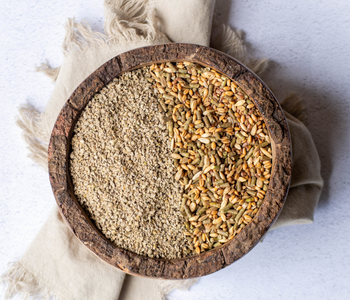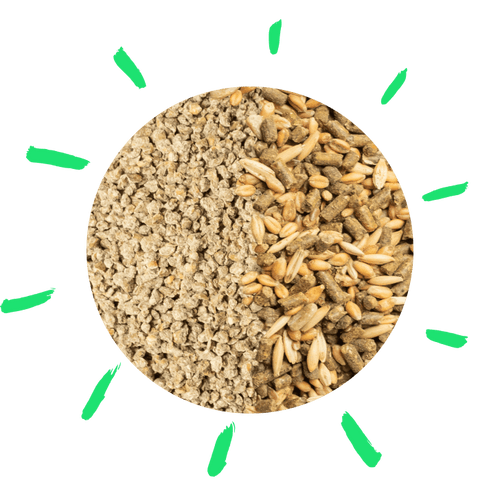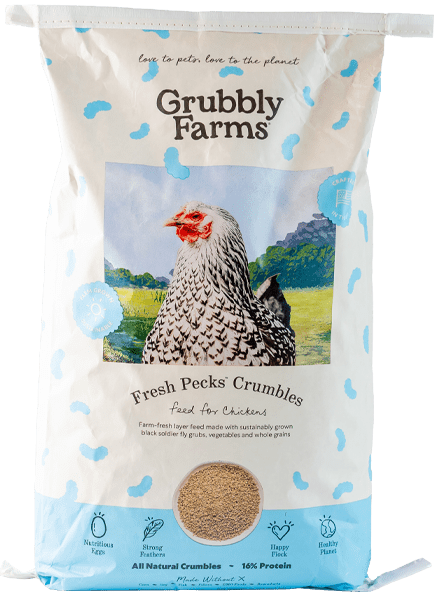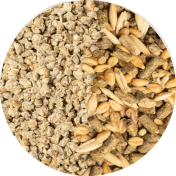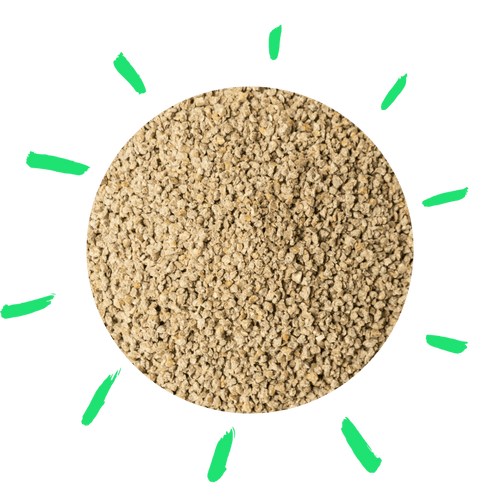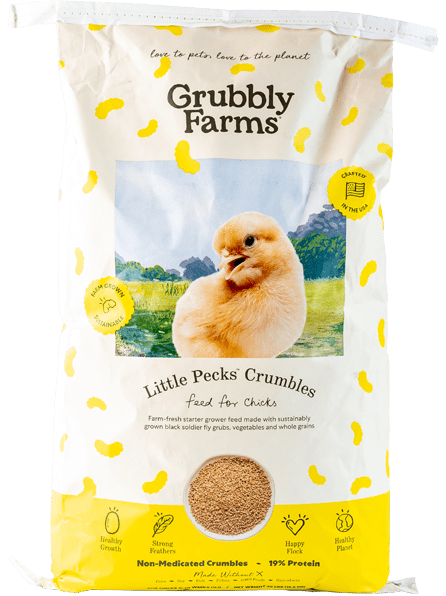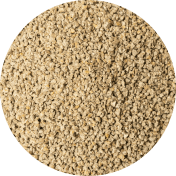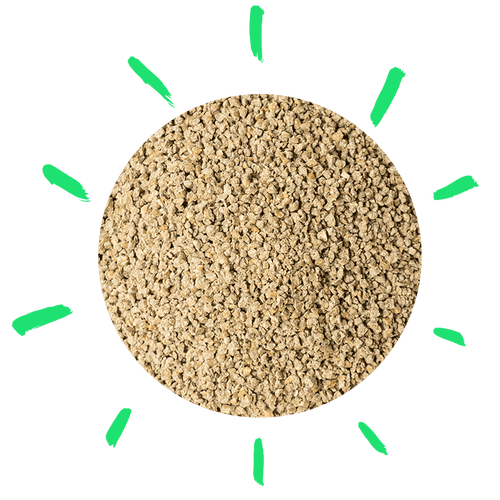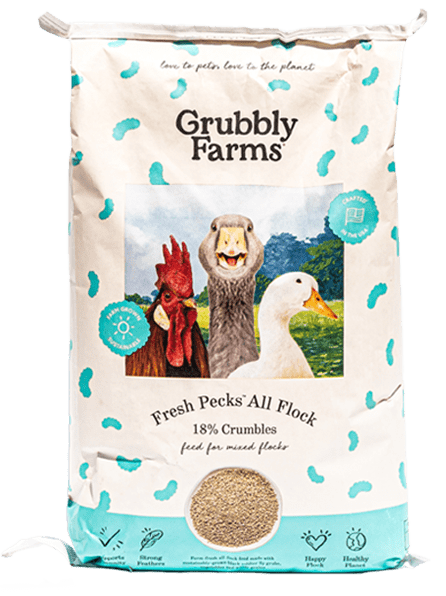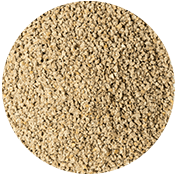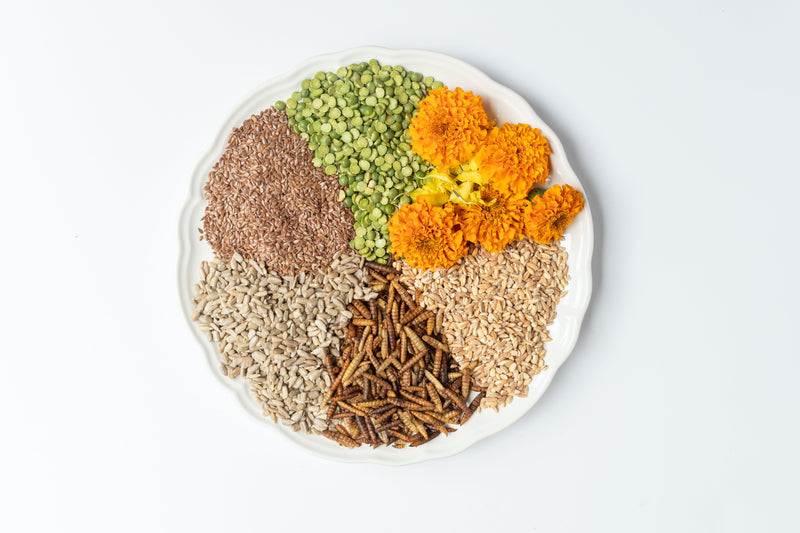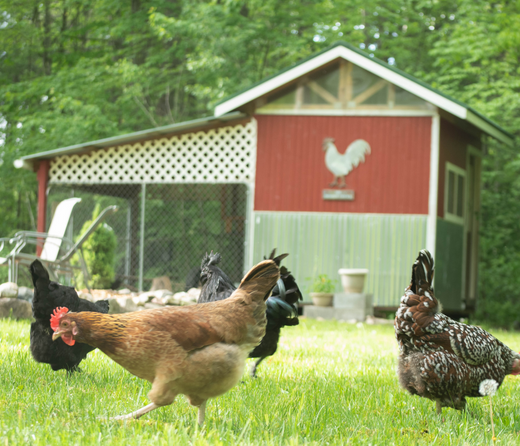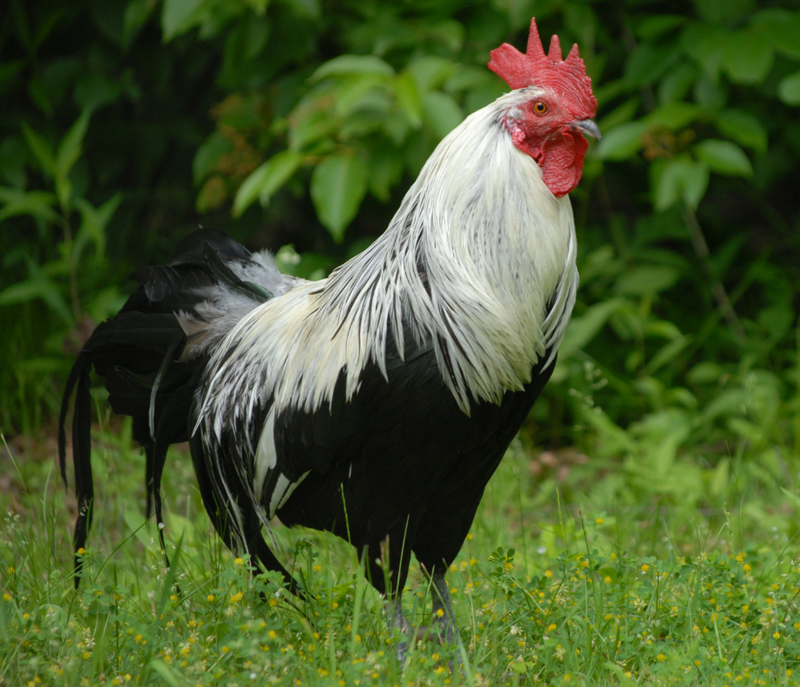Don’t let the various textures in chicken feed confuse you! Chicken feed can come in several different feed textures, but once you learn how to recognize the different textures and know their pros and cons, you can choose the best feed for your flock. Choosing the right feed texture for your flock will ensure that your flock likes their feed and that they are getting the best form of nutrition from their daily diet.

Why Does the Texture Matter?
Chicken feed texture refers to the form of chicken feed you buy. There are five main feed textures that chicken feed will come in:
- Mash
- Whole Grain
- Pellets
- Crumbles
- Textured Mix
Buying the correct feed texture for your flock will impact their health and development. Different feed textures affect a chicken’s eating habits and how the nutrients in the feed are absorbed. Some chickens prefer one feed texture over another depending on how they are raised and what they are raised for.
The Main Textures of Chicken Feed
The five main feed textures include mash feed, whole grain chicken feed, pellets, crumbles, and textured mix. A complete chicken feed will have all the nutrients a chicken needs daily no matter what texture it comes in. The variances in feed textures are mainly different ways of how the nutrients in a feed are provided. Each feed texture has pros and cons, which you should consider when choosing the right feed texture for your flock.

Mash Feed
Mash feed is composed of chicken feed ingredients, like grains, seeds, and legumes, that have been ground into a fine texture. The texture of mash chicken feed is similar to a fine potting soil. The feed ingredients in a mash chicken feed have not been processed and compressed into pellets. Instead, the individual feed ingredients are combined to create a mixture of ingredients that provide all the nutrients needed by a chicken. Mash chicken feed is typically minimally processed, however, the grains and legumes may be heat-treated before being mixed to reduce anti-nutritional factors.
Mash feed can be formulated for adult chickens and for baby chicks. Since the feed ingredients are broken down into small pieces and then mixed together, the feed particles are small enough for young chicks to consume. Since the whole grains, seeds, and legumes in the feed are crushed, they also become easier for young birds to digest.
Pros of Mash Feed
- Can easily be fermented
- Allows chickens freedom to customize their diet
Cons of Mash Feed
- Can be wasteful because chickens can scatter it or leave certain ingredients
- The process of creating mash also creates dust, which often gets wasted as chickens don’t consume the fine particles.
- More dust also means greater chance for respiratory issues
Whole Grain Chicken Feed
Whole grain chicken feed is feed that has been formulated from a mixture of whole grains, legumes, and sometimes various seeds. The grains, legumes, and seeds are left in their whole state and are not crushed or broken down. A plant-based or animal-based protein source is often included in the whole grain mix along with an additional vitamin and mineral supplement. The mixture of whole grains, legumes, seeds, protein, vitamins, and minerals provides the nutrition a chicken needs daily.
Whole grain chicken feed is often confused with scratch grains. Scratch grains are also whole grains. However, scratch grain mixes have not been formulated to supply the proper balance of carbohydrates, fats, protein, vitamins and minerals that a whole grain chicken feed supplies.
Whole grain chicken feed is formulated for adult birds. The whole grains, legumes, and seeds in the feed are too big for baby chicks to consume. Whole grain chicken feed is best fed to foraging chickens or to chickens who have been raised on a mash feed as chicks. Chickens who forage or who have been fed mash feed will have developed strong gizzards, which is necessary for breaking down the whole grains in the feed.
Pros of Whole Grain Feed
- Allows for diet diversity and customization
- Mimics natural foraging instincts
- Easily fermented
Cons of Whole Grain Feed
- Feed separation and possible waste
- Unbalanced diet possible if some feed ingredients are ignored

Pellet Chicken Feed
Probably one of the most common textures of chicken feed, pellet chicken feed is a processed form of chicken feed. Chicken feed ingredients are mixed and combined, then they are compressed into small cylindrical shapes called pellets. Each pellet has a uniform nutritional value since the feed ingredients cannot separate once they are pressed into a pellet.
Pellet chicken feed is developed for adult chickens and is often fed to laying hens and broilers. Since each pellet has uniform nutrition, it is easier to ensure that the birds are getting the proper nutrition needed for laying eggs or developing muscle.
Pros of Pellet Feed
- Easy to manage
- Ideal for feeders
- Provides uniform nutrition
Cons of Pellet Feed
- Not suitable for very young chicks
- Can be wasted from ‘beaking out’ and chickens not going back to clean up the spilled feed
- Less palatable for free-range birds or birds raised on mash feed

Crumble Chicken Feed
Crumble chicken feed is basically pellet feed that has been further processed and broken down into smaller pieces. Crumble chicken feed has a coarse, granular texture with small particle sizes. The small feed particles make crumble feed ideal for small birds and young chickens. Like pellet feed, crumbles have uniform nutritional value since the feed ingredients cannot separate.
Crumble chicken feed can be sold in the form of layer crumbles, starter crumbles, or grower crumbles. Each type of crumble is formulated for a certain age or purpose of chicken. Chicks and young birds are often fed starter crumble feed before being switched to layer pellet feed as adults.
Pros of Crumble Feed
- Easy for growing birds to digest
- Good for small beaks
Cons of Crumble Feed
- Can be a bit messy and cause more feed waste

Textured Mix Chicken Feed
Textured mix chicken feed is a hybrid between pellet feed and a whole grain feed. Whole grains, like corn, wheat, or barley, are combined with pellets which provide the finer parts of the diet, like vitamins, minerals, and protein. This allows a chicken some ability to customize its diet while ensuring the proper vitamins and minerals are consumed.
Textured mix chicken feed is formulated for adult chickens. The whole or cracked grains in the feed combined with the pellets makes the feed particles too large for baby chicks to consume. However, a textured feed mix is often preferred by adult birds who have been raised on a mash feed as chicks.
Pros of Textured Mix Feed
- Encourages natural foraging behavior
- Provides variety and allows for some customization
- Less waste as chickens are more likely to clean up the spilt grains
Cons of Textured Mix Feed
- Not ideal for young birds
- Can result in more feed waste if the birds do not consume the pellets
How to Choose the Right Texture Based on Your Flock's Needs
You can narrow down what feed texture to give your flock based on your flock’s needs. You will want to consider the age of chickens you are feeding, the breeds or purpose of your chickens, and flock size or feed preferences.

Age of the Chickens
Different feed textures are better for different ages of chickens. The digestibility and particle sizes of different feed textures will determine what feed is appropriate for certain ages of chickens.
- Chicks (0-6 weeks): Mash feed or crumble feed is ideal for early growth and is easy for young birds to digest.
- Young Pullets (6-20 weeks): Crumble feed is usually the best choice for growing birds since it provides uniform nutrition for proper growth and development.
- Adult Layers and Broilers: Pellets or crumbles provides consistent nutrition for egg production and weight gain.
- Foraging Adult Chickens: Textured mix feed, whole grain chicken feed, or mash feed supplements forage with a balanced diet that has a high nutritional value. Remember, whole grains or scratch grains that have not been combined with a protein source, vitamins, and minerals cannot replace a formulated feed.
Breed and Purpose of Your Chickens
If you are raising your chickens for a certain purpose, you will want to consider what feed texture will provide the best source of nutrition for your flock.
- Layers: Laying flocks and chicken breeds bred for laying often benefit from the efficiency and consistency of pellet feed. Mash feed or a textured mix are two other popular feed textures for laying flocks if you are supplying additional dietary supplements or allowing them to forage.
- Broilers: Broilers need a high energy diet to support their rapid growth. Pellet feed can provide that energy effectively and efficiently.
- Dual-Purpose Breeds: Heritage or dual-purpose chicken breeds may do well with mash feed, textured mix feed, or whole grain feed to engage their natural foraging instincts and give them some control over their diet.

Flock Size and Feeding Preferences
The size of your flock and feeding preferences may determine what chicken feed texture you should buy. For larger flocks, pellet or crumble feed can be easier to manage and distribute evenly. For flocks who are allowed to free-range, mash feed, whole grain feed, or a textured mix feed may be preferred as the chickens can also supplement their diet with forage.
Chickens who have been raised on a mash starter feed may prefer a mash layer feed, whole grain feed, or a textured mix feed as adults since they are used to the mixture of feed ingredients and may not find the compressed pellets or crumbles as palatable.
Common Mistakes to Avoid When Choosing Chicken Feed Textures
Choosing the right chicken feed texture based on your flock’s age, purpose, and preferences sounds simple. However, you should also make sure you are avoiding these mistakes when it comes to choosing a chicken feed texture:
Feeding Starter Mash or Starter Crumbles to Mature Chickens
Different types of chicken feed come in the various textures of chicken feed. For example, you can get starter crumbles or layer crumbles, starter mash or layer mash. When buying a certain feed texture, make sure it is formulated for the right age of chickens you are feeding. Starter crumbles and starter mash are formulated for young chicks, they will not provide the calcium, protein, and energy that laying hens, broilers, or adult chickens need.
Overfeeding Whole Grains or Scratch
Don't get whole grain chicken feed mixed up with scratch grains or plain whole grains. Whole grains by themselves, or scratch grain mixes, are not nutritionally complete. They lack the balance of protein, fats, carbohydrates, vitamins, and minerals that a whole grain chicken feed contains. Scratch grain mixes are high in energy but lack protein, vitamins, and minerals. They make a great wintertime treat, but they should not be your flock’s daily diet.
When fed in excess, scratch grains and whole grains can lead to nutrient imbalances and obesity. No matter the feed texture, all chicken feed contains some blend of whole grains, so when you are feeding your flock supplemental grains, do so in moderation. Supplemental whole grains and scratch grains should not exceed 10% of your flock’s daily diet.
Skipping Important Transitions Between Feed Textures
A chicken’s dietary needs change as it matures. You may find yourself switching between different feed textures when you buy different types of chicken feed for your birds as they grow and mature. For example, you may start baby chicks off on starter crumbles but then switch to layer pellets once the birds reach laying age. When a feed transition is skipped, it can inhibit proper growth or cause dietary deficiencies.
When switching between feed textures, you will want to do so gradually. If the two feeds have different nutritional values, a gradual transition can prevent dietary upsets from a change in protein levels. When switching between feed textures that have different protein levels, prolong the transition over a period of 2-3 weeks. If you are just switching feed textures, such as going from layer mash feed to layer whole grain feed, the transition can be made a litter quicker in about a week's time.

Conclusion
Chicken feed comes in several different texture options, including mash feed, whole grain feed, pellets, crumbles, and textured mixes. Choosing the right feed texture for your flock is important to ensure they get the best source of nutrition and will happily eat their daily feed. When deciding what feed texture to buy, consider your flock’s age, purpose, and feeding preferences. A complete chicken feed, no matter the texture, will keep your backyard flock happy and healthy!





